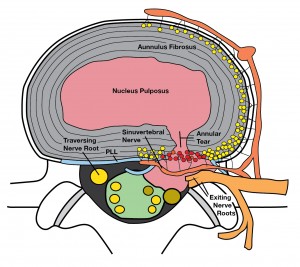
Most patients believe they have “injured” themselves when they develop pain and that when they have an absence of pain, the condition that was “injured” has “healed”. This model does not fit the data we have seen from the advanced imaging of patients who have an absence of pain. We have learned from MRI of our musculoskeletal system that key structures in our body are undergoing a process of degenerative attrition. We are wearing out! The most important of these three structures are the intervertebral discs of our back, the rotator cuff in the shoulder and the meniscus in the knee joint. These structures are progressively worn out with human activity. Data shows that 50% of 50 year olds will have degenerative cleavage tears in their medial meniscus, 60% of 60 year olds will have rotator cuff tears and the majority of people will have disc damage on their 40th birthday. These areas of degeneration, however, are found in people who often have no symptoms. Therefore, we can have damage to body parts without having any symptoms. We also know that these structures do not really repair themselves even after an episode of pain has come and gone. So, I tell patients that when they develop pain over the inside aspect of their knee joint, that they probably have “perturbed” their medial meniscus. When they come in complaining of pain over the anterolateral aspect of their shoulder joint, I tell them they have perturbed their rotator cuff. When they come in complaining of back pain after an innocent forward bending episode, I tell them that they have perturbed the intervertebral disc in their spine.
The clinician’s task is to help the patient to overcome the perturbation and allow the area to once again become pain free. The area typically does not heal, but is no longer generating pain. The generation of pain is a complicated process involving inflammation, activation of nerve endings, chemical mediators in both the periphery and the spinal cord, and these are all influenced by our psychosocial background. A simple way of thinking about this is that you can make your rotator cuff “angry” doing exercises like regular military press and, if you are 50, this can cause pain and limitation in function. You probably had degeneration of your rotator cuff before doing the exercises and the exercises stirred the area up into a painful state. When your symptoms resolve, the area of degeneration in the structure at hand probably has not changed. This is the concept of the perturbation, and it is a very useful model for understanding how the musculoskeletal works.
